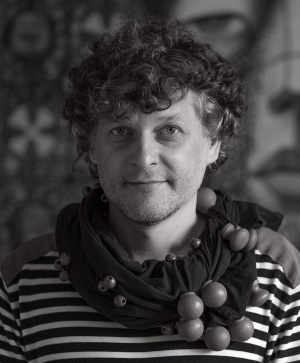SPARTACUS
The publication of Spartacus was part of a unique joint project with Russia’s State Academic Bolshoi Theatre. A handwritten score of the ballet is accompanied by engravings produced in a rare intaglio printing technique in traditional workshops in Paris.

Painter, graphic artist, sculptor, theatrical artist, writer, stage designer, designer of jewellery collections and interiors. One of the most successful living Russian artists, having won extensive recognition abroad and held more than 50 solo exhibitions.

Graphic artist, calligrapher, painter and sculptor. Participant in the 1st International Calligraphy Exhibition in Moscow in 2008 (and regularly thereafter), as well as many group and personal exhibitions in Russia and abroad. Member of the Artists’ Union of Russia.
Additional information
Details of the creation of this masterpiece
-
Year of publication:2016
-
Number of pages:98
-
Dimensions:360 × 520 mm
-
Paper:Vélin BFK Rives (France), 280 g/m², handmade
In the course of musings on the concept for Spartacus, the idea arose of simultaneously creating two books with different artistic interpretations, and the publisher Piotr Suspitsyn decided to try the experiment. Mamia Malazonia, a People’s Artist of Georgia and professor of Tbilisi Academy of Arts, was invited to work on one version, while the illustrations for the other version of Spartacus were produced by the Russian artist Yury Kuper.
The books differ in the artists’ approaches to the idea of illustration, the graphic techniques employed and the design. Mamia Malazonia’s Spartacus is closer in spirit to the first production of the ballet, staged by Leonid Yakobson, while Yury Kuper’s was created under the influence of Yury Grigorovich’s production. Each publication, though, is a masterfully executed work by an original artist and a paragon of contemporary book art.
Idea for the publication and financial support for the project — Roman Abramovich
Illustration, cover design, models for the creation of the copper reliefs, design for printing on silk — Yury Kuper
Handwritten calligraphic score — Denis Lotarev
Layout — Yevgeny Bolshakov
Printing of the heliographs — Matthieu Perramant and Ateliers Rigal (Paris)
Preparation of the plates — Fanny Boucher’s studio (France)
Printing of the libretto — Sergei Yashin
Creation of the copper reliefs — OOO Demetra, jewellery-makers (Moscow)
Binding work — Andrei Degtev, Andrei Kulikov
Musical consultant — Sergei Stadler
Project curator — Alexander Borodin
The source that he copied was the score in the Collected Works of Khachaturian (Vol. 11, Moscow: Muzgiz, 1982).
The text of the libretto was printed on a 19th-century Dingler hand press.
Since the technique of working with heliogravure (photogravure) has been lost in Russia, the preparation of the plates and printing of the heliographs was carried out in traditional private workshops in Paris, France.
The front cover of Spartacus is decorated with a copper relief in the form of a gladiator’s helmet made from an original model produced by the artist Yury Kuper.
The title is inlaid with enamel. The endpaper deserves particular attention – it is an original print on silk from the artist’s design.
The book has a storage case decorated with fabric.
Additional information
Details of the creation of this masterpiece
-
Year of publication:2016
-
Number of pages:98
-
Dimensions:360 × 520 mm
-
Paper:Vélin BFK Rives (France), 280 g/m², handmade
In the course of musings on the concept for Spartacus, the idea arose of simultaneously creating two books with different artistic interpretations, and the publisher Piotr Suspitsyn decided to try the experiment. Mamia Malazonia, a People’s Artist of Georgia and professor of Tbilisi Academy of Arts, was invited to work on one version, while the illustrations for the other version of Spartacus were produced by the Russian artist Yury Kuper.
The books differ in the artists’ approaches to the idea of illustration, the graphic techniques employed and the design. Mamia Malazonia’s Spartacus is closer in spirit to the first production of the ballet, staged by Leonid Yakobson, while Yury Kuper’s was created under the influence of Yury Grigorovich’s production. Each publication, though, is a masterfully executed work by an original artist and a paragon of contemporary book art.
Idea for the publication and financial support for the project — Roman Abramovich
Illustration, cover design, models for the creation of the copper reliefs, design for printing on silk — Yury Kuper
Handwritten calligraphic score — Denis Lotarev
Layout — Yevgeny Bolshakov
Printing of the heliographs — Matthieu Perramant and Ateliers Rigal (Paris)
Preparation of the plates — Fanny Boucher’s studio (France)
Printing of the libretto — Sergei Yashin
Creation of the copper reliefs — OOO Demetra, jewellery-makers (Moscow)
Binding work — Andrei Degtev, Andrei Kulikov
Musical consultant — Sergei Stadler
Project curator — Alexander Borodin
The source that he copied was the score in the Collected Works of Khachaturian (Vol. 11, Moscow: Muzgiz, 1982).
The text of the libretto was printed on a 19th-century Dingler hand press.
Since the technique of working with heliogravure (photogravure) has been lost in Russia, the preparation of the plates and printing of the heliographs was carried out in traditional private workshops in Paris, France.
The front cover of Spartacus is decorated with a copper relief in the form of a gladiator’s helmet made from an original model produced by the artist Yury Kuper.
The title is inlaid with enamel. The endpaper deserves particular attention – it is an original print on silk from the artist’s design.
The book has a storage case decorated with fabric.
Aram Khachaturian
SPARTACUS
A unique joint project of the publishing house and Russia’s State Academic Bolshoi Theatre
Download video presentation



